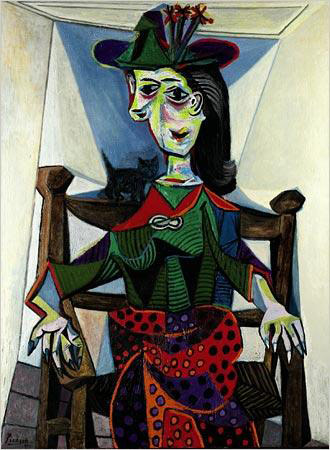| Dora Maar au Chat | |
|---|---|
 |
|
| Photo by: Wikipedia Creative Commons | |
| Artist | Pablo Picasso |
| Year | 1941 |
| Medium | Oil on canvas |
| Location | Private collection |
| Dimensions | 50.5 in × 37.5 in |
| 128.3 cm × 95.3 cm | |
Dora Maar au Chat by Pablo Picasso was painted in 1941 during the Second World War, during a difficult period as France was, at that time, occupied by Nazi Germany. The painting depicts Dora Maar, Picasso’s lover, sitting in a chair and there is a small cat sitting on her shoulders. While such is a simple theme for a painting, it is has the honor of being one of the most expensive paintings in the world. This particular portrait is one of many that Picasso painted during his ten year relationship with Dora Maar, which began when Picasso was fifty five years old. The portrait was obtained by Lee and Mary Block, art collectors from Chicago, very shortly after it was painted and was sold at auction for $95,216,000 in 2006.
Description of the Painting
The painting itself is not excessively large, measuring 50.5” by 37.5″ and shows Dora Maher in a three-quarter length pose, sitting regally in a wooden chair. There is a small black cat on her shoulders which some have described as looking like a combination of menacing and amusing. Picasso has used faceted planes to depict her body and has also used brushstrokes which have been layered richly, in order to project a sculptured quality. He has also used brilliant colors as well as thick and complicated patterns on her dress. The effect is powerful, as is the setting which is described as both dramatic, yet simple.
The setting shows an interesting composition of form, being characterized by vertically inclined planes, as depicted in the wooden floorboards and contrasting with a shallow inner space which has been said to resemble some of Picasso’s early work with space manipulation, as in the cubist style. Other elements of the painting must of necessity include a reference to, albeit brief, the stormy tension of German occupied France as well as the tension that was characteristic of the relationship between Maar and Picasso. He was frustrated with both situations and used the portraits and their abstract form, as a means of expressing it. She was his primary model for a 10 year period.
Weeping Woman
Dora Maar au Chat by Pablo Picasso has been described as one of the least hostile portraits of Maar, which seems to have been the norm, and this particular portrait has been depicted as one of Picasso’s most brilliant and provocative portraits of his weeping woman. The presence a cat in the same painting presents an allusion to the timeless combination of sexual aggression and feminine wiles. Picasso once described his lover’s temperament in terms of an Afghan cat, which is a significant illusory comment, considering the nature of their relationship.
In keeping with the reference to cats, it should be noted that Picasso has painted long fingers and long nails into the portrait and this closely resembles the reportedly well-manicured nails and hands that Maar was known to have. In fact, her hands were said to be her most distinctive and beautiful features, however Picasso has painted them in such a way as to depict them as possessing certain violence, like a cat’s claws.
Symbolism
Dora Maar au Chat possesses rich symbolism in the form of Dora Maher’s hat, in that it signifies an accessory for which she was very well-known, as well as her involvement in the surrealist movement. The attention which Picasso has paid to the hat contrasts with the rich patterning of her dress. He placed the hat as if it were a crown on her head, the bright red band and very colorful feathers adding to the symbolism. It is also said that Maar looks similar to a pagan goddess, due to the way that Picasso has seated her in the chair, in that the chair represents a throne. The way he has painted the angles of the chair, combined with the colors he has used, leaves this impression.
Final Words
Dora Maar au Chat, is an extraordinary painting in terms of its execution, selection of colors, attention to detail and the symbolism used. It also stands out from Picasso’s other portraits in that this one shows a three-quarter body pose rather than the head only, so the scope for rendering the qualities and frustrations as outlined above, was not only made possible, but brought to fruition.